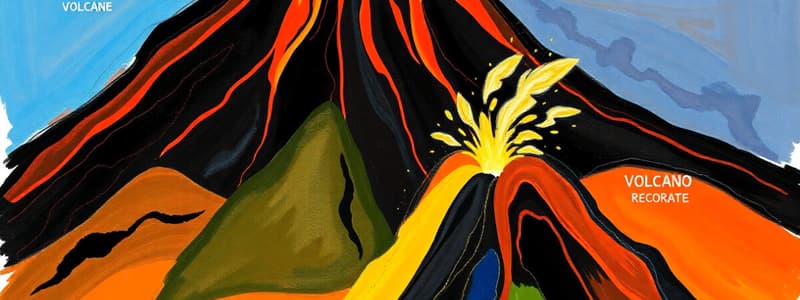Podcast
Questions and Answers
What is a caldera?
What is a caldera?
- A type of volcano characterized by gradual lava flows
- A volcanic eruption that is driven by steam
- A large volcanic crater formed by the collapse of rock after a magma chamber empties (correct)
- A funnel-shaped depression formed at the top of a volcano
Which type of volcano is characterized by steep slopes and wide craters, typically formed from ejected lava fragments?
Which type of volcano is characterized by steep slopes and wide craters, typically formed from ejected lava fragments?
- Composite volcano
- Caldera volcano
- Shield volcano
- Cinder cone volcano (correct)
What defines an active volcano?
What defines an active volcano?
- A volcano that erupts less frequently than once every hundred years
- A volcano that shows evidence of past eruptions
- A volcano that has not erupted in a millennium
- A volcano that has an ongoing record of eruptions (correct)
What characterizes a Plinian eruption?
What characterizes a Plinian eruption?
Which volcano is an example of a shield volcano?
Which volcano is an example of a shield volcano?
Which of the following is a primary characteristic of composite volcanoes?
Which of the following is a primary characteristic of composite volcanoes?
What is the primary role of volcanoes in Earth's ecosystem?
What is the primary role of volcanoes in Earth's ecosystem?
What is magma?
What is magma?
Flashcards
Volcano
Volcano
An opening in the Earth's surface where molten rock, smoke, gases, and ash are ejected.
Crater
Crater
A funnel-shaped depression at the top of a volcano formed by an explosive eruption.
Caldera
Caldera
A large volcanic crater formed when the magma chamber beneath a volcano empties and the surrounding rock collapses.
Magma
Magma
Signup and view all the flashcards
Lava
Lava
Signup and view all the flashcards
Shield volcano
Shield volcano
Signup and view all the flashcards
Cinder cone volcano
Cinder cone volcano
Signup and view all the flashcards
Composite volcano
Composite volcano
Signup and view all the flashcards
Study Notes
Defining Volcano Terminology
- A volcano is an opening in the Earth's surface where molten rock, smoke, gases, and ash are ejected.
- Mayon Volcano in the Philippines is an active volcano and notable for its perfect cone shape.
- A crater is a funnel-shaped depression at the top of a volcano formed by an explosive eruption.
- A caldera is a large volcanic crater formed when the magma chamber beneath a volcano empties and the surrounding rock collapses.
- Magma is hot, fluid, or semi-fluid material beneath or within the Earth's crust, typically made of molten rock.
- Lava is the molten rock that is ejected from a volcano.
Types of Volcanoes Based on Shape
- Shield volcanoes are broad, slightly domed structures formed by the accumulation of fluid lava flows. They resemble a warrior's shield, hence the name.
- Example: Mauna Loa in Hawaii
- Cinder cone volcanoes are built from ejected lava fragments. They have steep slopes, wide craters, and are the most common type of volcano. Also known as scoria cones.
- Example: Mount Parícutin in Mexico
- Composite volcanoes are tall, nearly perfect cone-shaped structures formed by alternating layers of lava and pyroclastic deposits (rock fragments ejected from a volcano). They are also known as stratovolcanoes.
- Example: Mayon Volcano in the Philippines
Types of Volcanic Eruptions
- Phreatic eruptions are steam-driven explosions caused by the contact of hot rocks with water.
- Example: Taal Volcano eruption in January 2020.
- Phreatomagmatic eruptions are violent eruptions caused by the interaction of water and magma.
- Strombolian eruptions are characterized by periodic, weak to violent eruptions with fountaining lava.
- Vulcanian eruptions are characterized by tall, explosive eruptions reaching up to 20 kilometers high, with pyroclastic flows and ash.
- Plinian eruptions are the most explosive type of eruption, with large amounts of gas and pyroclastic materials.
- Example: Mount Pinatubo eruption in 1991.
Volcano Activity Classification
- Active Volcanoes have a record of eruption.
- Inactive Volcanoes show no activity and have no record of eruption.
- Example: Mount Kanlaon in Negros Occidental, Philippines.
Importance of Volcanoes
- Volcanoes have a significant role in sustaining life on Earth.
- They release heat and gases that contribute to the Earth's atmosphere and help regulate climate.
- Volcanic activity also creates fertile soil, contributing to agriculture.
Studying That Suits You
Use AI to generate personalized quizzes and flashcards to suit your learning preferences.




